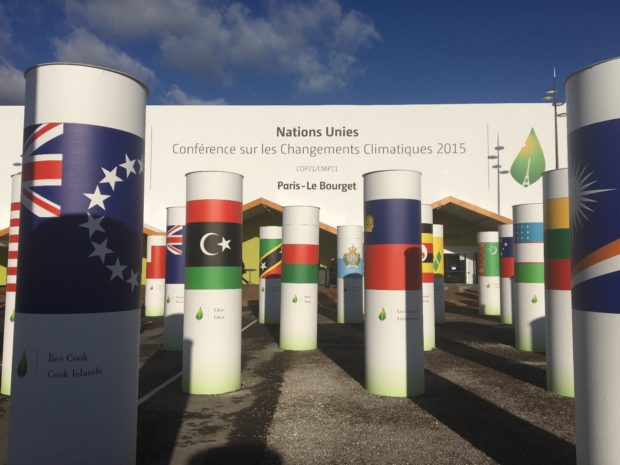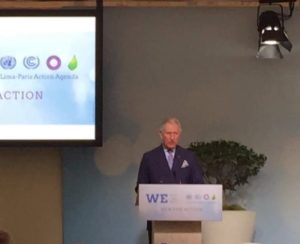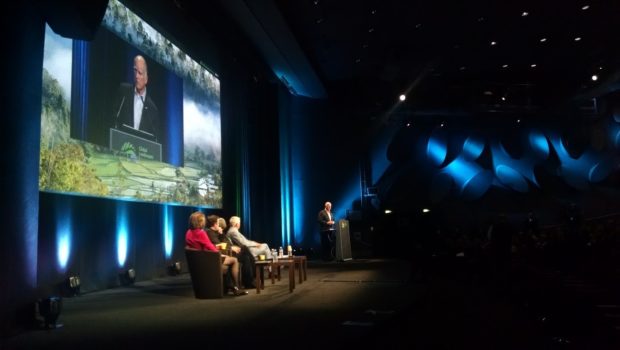We have much more to do and your continued support is needed now more than ever.
NWF in Paris: COP21 Update

COP21 is a momentous meeting. By the end of the two-week long conference, the hope is that the more than 190 countries present will have come to an agreement to tackle carbon pollution and climate change, a necessary move to protect wildlife, people, and our planet. As our “Wildlife in Hot Water” report showed this summer, climate change affects many of our iconic wildlife species throughout the U.S. – including many migratory birds which must fly south to winter in the warm tropical forests of Latin America. Protecting these forests is critical for wildlife habitat and our climate, as trees play an incredibly important role in sequestering carbon pollution – so forest conservation is a major aspect of the climate change agreement.
State of the Discussions
Since the meeting in Lima last year (COP20), countries have been announcing their “Intended Nationally Determined Contributions” (or INDCs). These INDCs include countries’ emissions reductions targets, which form the basis for the Paris agreement. Country Parties have also met throughout the year to continue drafting the text of the “2015 Paris Outcome,” and the negotiations went into high gear last week, the first week of the COP.

- Support (finance for poorer countries and capacity building help to enable them to adopt clean energy).
- Differentiation (differences in commitments between developed and developing countries).
- Ambition and the long-term goal (including how often countries will take stock of progress made in reducing emissions and revise their commitments).
- Acceleration of pre-2020 ambition (how to incentivize reductions that can be made before 2020).
There is disagreement about the overall goal of the agreement: whether it should aim to limit warming to 2.0°C or 1.5°C. While this difference may seem small, the amount of warming that takes place over the next few decades has a big impact on weather patterns, human communities, and wildlife.
While these overarching climate disagreements are playing out, the National Wildlife Federation team in Paris has been focused on one key issue that should be included in the agreement – land use and REDD+ (Reducing Emissions from Deforestation and Forest Degradation). REDD+ is a framework to reduce carbon emissions from deforestation. The land sector, principally agriculture, and land use change, mostly deforestation, contribute significantly to global emissions (almost a quarter of all emissions).
Forests and wetlands play an important role as global carbon sinks, sequestering carbon pollution from the atmosphere. Improvements in land use, such as “climate smart agriculture,” are also uniquely tied to global food security and wildlife conservation. We are fighting with a coalition of like-minded NGOs to keep the land use sector in the Paris agreement, and we will continue to do so during the high-level ministers’ discussions in the upcoming week.

Forests in Focus
Though the extent to which the land sector will be included in the Paris agreement remains unclear, many countries and the private sector have made it clear during the first week of the COP that reducing deforestation and considering land sector emissions are important. Announcements in this regard were made throughout the COP, especially during two large programs focused specifically on forests last week.

A small selection of announcements made last week are listed here:
- Germany, Norway, and the UK announced $5 billion in aid from 2015-2020 to developing countries with signification forest cover who are able to demonstrate emissions reductions. Colombia also announced a collaborative partnership with these 3 governments for $300 million to scale up its deforestation reduction efforts.
- Marks & Spencer and Unilever pledged responsible sourcing for major commodities, including those that NWF works on such as beef and palm oil. Overall, 42 major companies have made similar commitments under the We Mean Business Coalition. This is on top of declarations made last year at the New York Climate Summit.
- The Global Forest Observation Initiative (GFOI) set up by the Group on Earth Observations, whose members include 90 governments along with larger regional and intergovernmental bodies, released new data from its second satellite. The U.S. is one of the leading members of this initiative, which provides radar images for monitoring deforestation without the limitations, such as inability to see through clouds (common over tropical forests), that have plagued existing optical imaging.
- The second annual edition of the Forest 500 was launched. This project, led by Global Canopy Programme (GCP) and supported by NWF, ranks the 500 most influential companies, investors, and governments with the greatest potential to reduce deforestation. Forest 500 is the world’s first rainforest rating agency, and is an integral component of the global effort to protect wildlife habitat and reduce the loss of tropical forests.
- Danone announced it will peak its emissions corporation-wide in the next 10 years and take responsibility for deforestation across its entire supply chain.
- Ten African countries stated their commitment to restore 100 million hectares of land by 2030, known as the African Forest Landscape Restoration Initiative (AFR100).
- Indonesia officially launched the Indonesian National Carbon Accounting System (INCAS), which will display emissions data for the country and each of its 34 provinces.
Meanwhile, on other fronts, one of the most important commitments came from the African Renewable Energy Initiative (AREI) which set out a goal to build 100GW of new renewable energy (RE) capacity by 2020 and an overall goal to generate 300GW of RE in Africa by 2030. Current electricity generation from all sources in Africa is 150GW, so this initiative is huge both in environmental and developmental terms.

Stay Tuned
We’ll be continuing to work over the next week to keep land use in the agreement and will send updates in the upcoming days on the National Wildlife Federation’s two side events at the COP – focusing on “Zero-deforestation Commodity Supply Chains: Linking Corporate Actions with REDD+” and “Deforestation-free Agriculture: Converting Pledges into Action.” Stay tuned for more on all of this at the end of the week, and, with any luck, news of an ambitious agreement!
Follow the NWF international team on Twitter @NWF_Intl for more updates of COP21!





















